Geosciences occupies part of the renovated Cyril Moore Science Center. The Division of Science has several major analytical instruments acquired with funding through competitive grants from the National Science Foundation. The analytical capabilities for materials characterization rivals those of just about any undergraduate geology program. Students learn to use the instrumentation in courses, and they can then use these instruments free of charge in their own research projects. Major instruments available for use include:
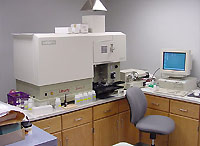 |
ICP spectrometer - for chemical analysis of water samples, and minerals and rocks that have been put into solution. |
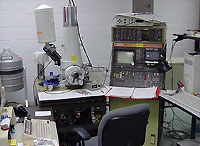 |
Scanning electron microscope (SEM) - for high magnification study of minerals and fossils, and microanalysis (spot chemical analysis) of solid materials. |
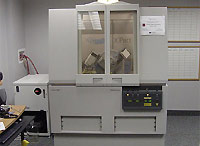 |
X-ray diffractometer (XRD) - for analysis of powdered samples of crystalline materials; produces a diffraction pattern (like a fingerprint) that reflects the atomic structure(s) of phases in the sample. |
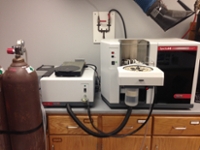 |
Atomic Absorption Spectrophotometer (AA) - used to look at the absorption of metal atoms and metal ions in solution. It allows the determination of many metals even at very low concentrations. It has been used in undergraduate research studies involving Cadmium, Lead, and Lithium. It is an important instrument for analytical chemistry. |
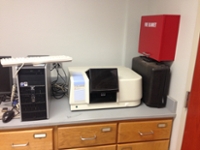 |
Fourier Transform Infrared Spectrometer (FTIR) - is used to look at infrared absorption by molecules. It can be very useful in identifying structural groups, especially on organic molecules. This is important for identification of compounds. |
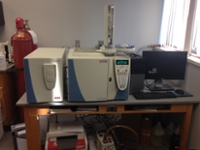 |
Gas Chromatography Mass Spectrometer (GCMS) - used to separate substances in mixtures and Mass Spectroscopy is used to identify the components in the mixture. Undergraduate research projects on effectiveness of cleanup methods involving methamphetamine contamination and determination of caffeine in saliva have relied on this instrument. |
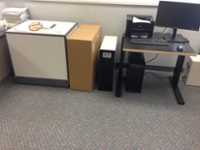 |
Nuclear Magnetic Resonance Spectrometer (NMR) - an important instrument used in organic chemistry. It uses the combination of magnetic and radio frequency fields to look at the spins of nuclei, such as the hydrogen 1 nucleus. This interaction depends on the chemical environment of the nucleus so NMR is extremely useful for determining molecular structure. |
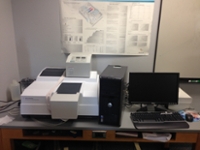 |
Ultraviolet Visible Spectrophotometer (UV-vis) - used to look at the absorbance of molecules, especially molecules in solution. This instrument is used extensively in courses at the 200 level and above, including analytical courses, biochemistry courses and physical chemistry courses. It has been used for research projects involving properties of molecules and water quality studies. |
Minot State University Giving Day Division of Science funding priorities.
The Division of Science' Giving Day priorities are to fund instrumentation maintenance, repair, and replacement. The wear and tear on these instruments are not insubstantial - moving parts must be serviced and lubricated, pumps tested, X-ray tubes replaced, software and hardware updated or re-written. All of these are 'hidden costs' associated with procurement and use of these instruments, and without these vital services, these instruments will cease to function.
Unfortunately, such is the case with our SEM. The software for our Scanning Electron Microscope only runs on Windows XP, which is no longer supported by either Microsoft or the University system. The software key has become corrupted and as a result, the software no longer functions. Because this instrument runs only on Windows XP and because people do not write software for this operating system any longer, we need either 1) to have custom software written for this application, or 2) to purchase a new SEM. Thus, we can break down our Giving Day needs into two broad categories:
1. Smaller-scale Initiatives.
This category includes maintenance for our operational instrumentation. This includes money for maintenance of the XRD and ICP. The much needed maintenance of each of these instruments will likely cost several thousand dollars. The Geoscience department needs to replace its leaking stream table with a new stream table that will cost an estimated $3,000 to $4,000. We have several microscopes that no longer work and need to be replaced. Student-grade reflected light microscopes with LED light sources currently cost between $1,500 and $2,000 each; pertographic scopes easily cost double this.
2. Larger-Scale Initiatives.
This category includes important instrumentation purchases that are not currently able to be made with University resources. The Chemistry Department seeks funding for an HPLC. The Division of Science (Geoscience and Chemistry together) seek funding for an ICP and a new SEM. Each of these instruments costs more than $50,000. If you are interested in helping to fund one of these instruments, please contact the office of the VPAA.



